Portuguese Restoration War
| Portuguese Restoration War | |||||||||
|---|---|---|---|---|---|---|---|---|---|
| Part ofAnglo-Spanish WarsandFranco-Spanish Wars | |||||||||
 German engraving from the 1650s representing the episodes of the Portuguese restoration of independence. Clockwise from top left:
| |||||||||
| |||||||||
| Belligerents | |||||||||
| Commanders and leaders | |||||||||
TheRestoration War(Portuguese:Guerra da Restauração), historically known as theAcclamation War(Guerra da Aclamação),[7]was the war betweenPortugalandSpainthat began with the Portuguese revolution of 1640 and ended with theTreaty of Lisbonin 1668, bringing a formal end to theIberian Union.The period from 1640 to 1668 was marked by periodic skirmishes between Portugal and Spain, as well as short episodes of more serious warfare, much of it occasioned by Spanish and Portuguese entanglements with non-Iberian powers. Spain was involved in theThirty Years' Waruntil 1648 and theFranco-Spanish Waruntil 1659, while Portugal was involved in theDutch–Portuguese Waruntil 1663.
In the seventeenth century and afterwards, this period of sporadic conflict was simply known, in Portugal and elsewhere, as theAcclamation War.The war established theHouse of Braganzaas Portugal's new ruling dynasty, replacing theHouse of Habsburgwho had been united with the Portuguese crown since the1580 succession crisis.[5]
Events leading to revolution
[edit]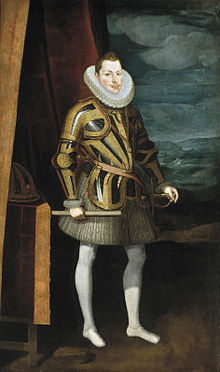
WhenPhilip II of Portugal (III of Spain)died in 1621, he was succeeded by his sonPhilip III of Portugal (IV of Spain)who followed a different approach to Portuguese concerns. Portuguese merchants saw higher taxes, the Portuguese nobility began to lose its influence at the SpanishCortes,and Spaniards increasingly occupied the government's posts in Portugal.
Moreover, Spain entangled Portugal in the efforts to suppress the independence of theDutch Republicduring theEighty Years' War.In response, the Dutch embarked on systematic attacks on Portuguese colonies and outposts, either pillaging or occupying them in what is known as theDutch–Portuguese War.Spanish preoccupation with defending their own empire, particularly in theThirty Years War,left Portuguese interests in Asia and Brazil neglected.[8]
The situation culminated in a revolution organized by the nobility andbourgeoisie,executed on 1 December 1640, sixty years after the crowning ofPhilip I(Philip II of Spain), the first "dual monarch".
The plot was planned byAntão Vaz de Almada,Miguel de AlmeidaandJoão Pinto Ribeiro.They, together with several associates, known as theForty Conspirators,killed theSecretary of State,Miguel de Vasconcelos,and imprisoned the king's cousin,Margaret of Savoy,who had been governing Portugal in his name. Philip's troops were then fighting theThirty Years' Warand also facing a revolution in thePrincipality of Catalonia,which became known as theReapers' War.
The support of the people became apparent almost immediately and within a matter of hours, Philip III's third cousinJohn, 8th Duke of Braganza,was acclaimed as King John IV of Portugal. The news spread quickly throughout the country. By 2 December 1640, the day after the coup, John IV, acting in his capacity as sovereign of the country, had sent a letter to the Municipal Chamber ofÉvora.
The ensuing conflict with Spain brought Portugal into the Thirty Years' War as at least a peripheral player. From 1641 to 1668, the period during which the two nations were at war, Spain sought to isolate Portugal militarily and diplomatically, and Portugal tried to find the resources to maintain its independence through political alliances and maintaining its colonial income.
Preparations for war
[edit]Immediately after assuming the Portuguese throne, John IV took several steps to strengthen his position. On 11 December 1640, a 'Council of War' was created to organize all of the operations. Next, the king created the 'Junta of the Frontiers' to take care of the fortresses near the border, the hypothetical defense of Lisbon, and the garrisons and sea ports.[9]
A year later, in December 1641, he created a tenancy to assure that all of the country's fortresses would be upgraded and that the improvements would be financed with regional taxes. He also organized the army, re-established the 'Military Laws ofKing Sebastian',[9]and undertook a diplomatic campaign focused on restoring good relations with England.
After gaining several small victories, John tried to make peace quickly.[10]However, his demand that Philip recognize the new ruling dynasty in Portugal was not fulfilled until the reign of his son,Afonso VI,during the regency of Peter of Braganza, another of his sons, who later became KingPeter II of Portugal). Confrontations with Spain lasted 28 years.
Context: relations among the European powers
[edit]
Relations between France and Spain
[edit]Cardinal Richelieu,the chief adviser toLouis XIII of France,was fully aware of the fact that France was operating under strained circumstances. Louis was at war with Spain at that time; he had to control rebellions withinFrancethat were supported and financed by Madrid and had to send French armies to fight the Spanish Habsburgs on three different fronts. In addition to their shared frontier at thePyrenees,Philip IV of Spain,formerly Philip III of Portugal as well, reigned, under various titles, inFlandersand theFranche-Comté,to the north and east of France. In addition, Philip IV controlled large territories in Italy, where he could, at will, impose a fourth front by attacking French-controlledSavoy.[a][11]
Spain had enjoyed the reputation of having the most formidable military force in Europe, with the introduction of thearquebusand the so-called "Spanish School", but that reputation and tactic had diminished with the Thirty Years' War. Nevertheless, the consummate statesman, Richelieu, decided to force Philip IV to look to his own internal problems. To divert the Spanish troops besieging France, Louis XIII, on the advice of Richelieu, supported John's claim during the Acclamation War on the reasoning that a Portuguese war would drain Spanish resources and manpower.
Relations between Portugal and France
[edit]To fulfill the common foreign policy interests of Portugal and France, a treaty of alliance between the two countries was concluded at Paris on 1 June 1641. It lasted eighteen years before Richelieu's successor as unofficial foreign minister,Cardinal Mazarin,broke the treaty and abandoned his Portuguese andCatalanallies to sign a separate peace with Madrid.[11]TheTreaty of the Pyreneeswas signed in 1659. Under its terms, France received the portion of thePrincipality of Catalonianorth of the Pyrenees, known as theRoussillon,and part of theCerdanya(French Cerdagne). Most important to the Portuguese, the French recognised Philip IV of Spain as the legitimate king of Portugal.
Seven years later, in the late stages of the Portuguese Restoration War, relations between the two countries thawed to the extent that the young (but sickly)Afonso VI of Portugalmarried a French princess,Marie Françoise of Nemours.
Relations between Portugal and the Dutch Republic
[edit]
At the time of the revolution in Lisbon (1 December 1640), the Portuguese had been at war with the Dutch for nearly forty years. A good deal of the conflict can be attributed to the fact that Spain and theDutch Republicwere concurrently engaged in theEighty Years' War(1568–1648), and, ever since hostilities between Portugal and the Dutch Republic erupted in 1602, Portugal had been ruled by a Spanish monarch.
TheDutch-Portuguese Warwas fought almost entirely overseas, with the Dutch mercantile surrogates, theDutch East India Companyand theDutch West India Company,repeatedly attacking Portugal's colonial possessions in the Americas, in Africa, in India, and in the Far East. Portugal was in a defensive posture throughout, and it received very little military help from Spain.
After the acclamation of John, the pattern persisted all over the Portuguese Empire until the final expulsion of the Dutch fromAngola(1648),São Tomé(1649), andBrazil(1654). The Dutch signed a European truce with Portugal, helping each other somewhat against their common enemy, Spain. The Dutch resumed buying salt in theSetúbalsalt factories, restarting commerce between the two countries for the first time since 1580, when the Spanish branch of theHabsburgs,against whom theDutch were in revolt,had assumed the Portuguese throne. However, Dutch attacks on Portuguese territories persisted until 1663, even after the signing of theTreaty of The Haguein 1661.
Relations between Portugal and England
[edit]England was then embroiled inits own civil war.Portuguese problems in dealing with England arose from the fact that the English Parliament fought and won its anti-royalist war while, at the same time, Portugal's royal court continued to receive and recognizeEnglishprinces and nobles. The strained relations persisted during the short-livedCommonwealth period,when the republican government that had deposedCharles Iruled England and then Ireland and Scotland.
After the restoration of theStuart dynasty,it became possible for Portugal to compensate for the lack of French support by renewing its alliance with England,[12]with experienced soldiers and officers available from the demobilisedNew Model Army.That took the form of a dynastic marriage in 1662 betweenCharles IIandAfonso VI's sister,Catherine of Braganza,which assured Portugal of outside support in its conflict with Spain. The English alliance helped peace with Spain, which had been drained by theThirty Years' Warand had no stomach for further warfare with other European powers, especially a resurgent England.
War
[edit]Militarily, the Portuguese Restoration War consisted mainly of border skirmishes and cavalry raids to sack border towns, combined with occasional invasions and counter-invasions, many of them half-hearted and under-financed. There were only five major set-piece battles during twenty-eight years of hostilities.
The war may be considered to have had three periods:
- first,an early stage (1640–1646) when a few major engagements demonstrated that the Portuguese could not be easily returned to submission to the Spanish Habsburgs,[13]
- second,a long period (1646–1660) of military standoffs, characterized by small-scale raiding, while Spain concentrated on its military commitments elsewhere in Europe,[14]
- third,a final period (1660–1668) during which the Spanish king, Philip IV, unsuccessfully sought a decisive victory that would bring an end to hostilities.[11]
First stage: battles
[edit]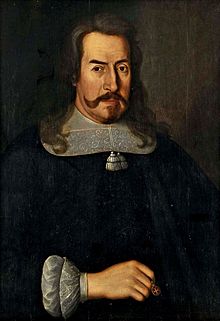
Hoping for a quick victory in Portugal, Spain immediately committed seven regiments to the Portuguese frontier, but delays by the Count of Monterrey, a commander with more interest in the comforts of life at camp than the battlefield, squandered any immediate advantage. A Portuguese counter-thrust in late 1641 failed, and the conflict soon settled into a stalemate.
Battle of Montijo
[edit]On 26 May 1644, a large column of Spanish troops and mercenaries, commanded by NeapolitanCarlo Andrea Caracciolo,marquis of Torrecuso, was stopped at theBattle of Montijoby the Portuguese, who were led by theMatias de Albuquerque,one of a number of experienced Portuguese colonial officers who rose to prominence during the war.
Scope of the war
[edit]
Three theaters of warfare were eventually opened, but most activity focused on the northern front, near Galicia, and on the central frontier between PortugueseAlentejoand SpanishExtremadura.The southern front, where the PortugueseAlgarveabuts SpanishAndalusia,was a logical target for Portugal, but it was never the focus of a Portuguese attack, probably because the Portuguese queen,Luisa de Guzmán,was the sister of theDuke of Medina Sidonia,the leading noble of Andalusia.
Attrition and corruption
[edit]Spain, at first, made the war a defensive one. Portugal, for its part, felt no need to take Spanish territory in order to win, and it too was willing to make the war a defensive contest. Campaigns typically consisted ofcorrerias(cavalry raids) to burn fields, sack towns, and steal large herds of enemy cattle and sheep. Soldiers and officers, many of them mercenaries, were primarily interested in booty and prone to desertion. For long periods, without men or money, neither side mounted formal campaigns, and when actions were taken, they were often driven as much by political considerations, such as Portugal's need to impress potential allies, as by clear military objectives. Year after year, given the problems of campaigning in the winter, and the heat and dry conditions of summer, most of the serious fighting was confined to two relatively short "campaigning seasons" in the spring and autumn.[13]
The war settled into a pattern of mutual destruction. As early as December 1641, it was common to hear Spaniards throughout the country lament that "Extremadurais finished. "Tax collectors, recruiting officers, billeted soldiers, anddepredationsby Spanish and foreign troops were loathed and feared by the Spanish population as much as raids by the enemy. In Extremadura, local militias bore the brunt of the fighting until 1659, and the absence of these part-time soldiers was extremely harmful to agriculture and local finances. Since there was often no money to pay or support the troops (or to reward their commanders), the Spanish crown turned a blind eye to the smuggling, contraband, profiteering, disorder, and destruction that had become rampant on the frontier. Similar conditions also existed among the Portuguese.
Second stage: defensive standoff
[edit]
The war was also expensive. In the 1650s, there were over 20,000 Spanish troops in Extremadura alone, compared to 27,000 inFlanders.Between 1649 and 1654, about 29 percent (over six millionducats) of Spanish defence spending was appropriated for fighting Portugal, a figure that rose during the major campaigns of the 1660s.[15]Portugal was able to finance its war effort because of its ability to tax the spice trade with Asia and the sugar trade from Brazil, and it received some support from the European opponents of Spain, particularly France and England.[10]
The 1650s were indecisive militarily but important on the political and diplomatic fronts, with the brief exception of theBattle of the Lines of Elvasin 1659. The death of John IV in 1656 signalled the beginning of the regency of his wife, followed by a succession crisis and a palace coup (1662). Despite these domestic problems, the expulsion of the Dutch from Brazil (1654) and the signing of a treaty with England (also in 1654) improved Portugal's diplomatic and financial position temporarily and gave it needed protection against a naval raid on Lisbon.
Nonetheless, the overriding goal, a formal pact with France, continued to evade Portugal, whose weakness and isolation had been driven home by its virtual exclusion at the negotiations for the European settlement-of-settlements, the newrealpolitikof thePeace of Westphalia(1648).
With this treaty and the end of hostilities in Catalonia in 1652, Spain was again ready to direct its efforts against Portugal, but it faced a lack of men, resources, and, especially, good military commanders.[16]
Atrocities
[edit]During the second stage, the war became afrontierconfrontation characterized by attrition, often featuring local forces composed of familiar neighbors, yet this intimacy failed to temper the brutality exhibited by both sides. Soldiers and officers, many mercenaries facing payment shortages, turned to looting and desertion. The Portuguese sought retribution for grievances accumulated during sixty years of Spanish rule, whereas the Spanish viewed their adversaries not as legitimate combatants deserving of honorable treatment but as rebels.[14]
Third stage: Portuguese victory
[edit]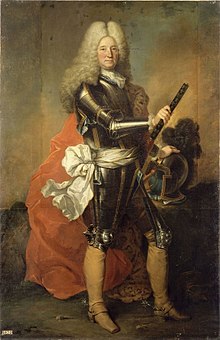
Following the indecisive campaigns of 1662, Spain launched a major effort to win the war. In April 1663,John of Austria the Younger,Philip IV's illegitimate son, invadedAlentejo,commanding an army of 20,000 provisioned for six weeks.[17]In May, he successfully captured Évora, sparking a surge of emotion in Lisbon and raising alarm throughout Portugal, as there was now no major barrier to impede a Spanish advance on Lisbon.[18]
The Portuguese, underAntónio Luís de Meneses, 1st Marquess of Marialva,were bolstered by the arrival of a British brigade which numbered 3,000 in August 1662. Many were veterans of theEnglish Civil Warand the Dutch Revolt.[19]For KingCharles II,this was a convenient way of getting rid of demobilized soldiers of Cromwell'sNew Model Armyand removing them from English territory. They were led by the Germansoldier of fortune,Friedrich Hermann von Schönberg,Count of Mértola,The brigade, under Schomberg's leadership, proved a decisive factor in winning back Portugal's independence.[20]
They defeated the Spanish in a major engagement atAmeixialon 8 June 1663, and this forced John of Austria to abandon Évora and retreat across the border with heavy losses.
The Portuguese now had some 30,000 troops in the Alentejo-Extremadura theatre, but they could not draw the Spanish again into a major engagement until June 1665, when a new Spanish commander, theMarquis of Caracena,took overVila Viçosawith about 23,000 men, including recruits from Germany and Italy.[21]
The Portuguese relief column under António Luís de Meneses and Schomberg met them atMontes Claroson 17 June 1665. The Portuguese infantry and artillery emplacements broke the Spanish cavalry, and the Spanish force lost over 10,000 men, including casualties and prisoners. Shortly thereafter, the Portuguese retook Vila Viçosa. These were the last major engagements of the war.
Both sides returned to skirmishing campaigns. Portugal, with the intercession of its English ally, had sought a truce, but after the decisive Portuguese victory at Montes Claros and with the signing of aFranco-Portuguese treaty in 1667,the Spanish Habsburgs finally agreed to recognize the House of Braganza as Portugal's new ruling dynasty on 13 February 1668.
Recapitulation
[edit]The five major battles of the war were:
- Battle of Montijoon 26 May 1644
- Battle of the Lines of Elvason 14 January 1659
- Battle of Ameixialon 8 June 1663
- Battle of Castelo Rodrigoon 7 July 1664
- Battle of Montes Claroson 17 June 1665
The Portuguese were victorious in almost all of these engagements, and peace was concluded, with the help of English mediation, by theTreaty of Lisbonin 1668.
Timeline
[edit]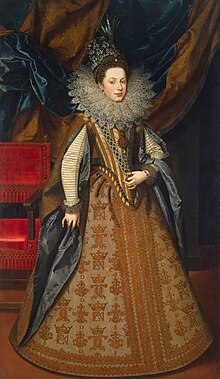

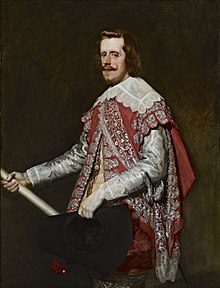

- 1640:A small group of conspirators stormed the royal palace in Lisbon and deposed theVicereine of Portugal,Margaret of Savoyon 1 December 1640. She famously tried to calm the Portuguese people during demonstrations in theTerreiro do Paço,at the time, Lisbon's main square, but her efforts failed. TheDuke of Bragança,head of the senior family among the Portuguese nobility, accepted the throne as John IV of Portugal later the same day. John's entire reign was dominated by the struggle to maintain Portuguese independence.
- 1641:A counter-revolution mounted by theInquisitionfailed. It was quelled byFrancisco de Lucena,who had its leaders executed. Miguel Luís de Menezes, 2nd Duke of Caminha, was executed for continuing to support the Habsburgs' claim to the Portuguese throne.
- 1641:Portugal signed alliances with France (1 June 1641) andSweden(August 1641).
- 1641:Portugal and the Dutch Republic signed a 'Treaty of Offensive and Defensive Alliance', otherwise known as theTreaty of The Hague,on 12 July 1641. The treaty was not respected by either party; as a consequence, it had no effect on the Portuguese dependencies of Brazil and Angola that were under Dutch occupation.
- 1641:The Dutch began their occupation ofSão Toméand ofAno Bomon 16 October 1641, where they remained until 6 January 1649. This was clearly a violation of the agreement made with Portugal only three months earlier.
- 1641:Portugal wasousted from Malaccaby the Dutch.
- 1642:The Dutch took over all of thePortuguese Gold Coast(now Ghana).
- 1643:At theBattle of Rocroi(19 May 1643), in theArdennes,the French defeated the Spanish.
- 1644:TheBattle of MontijonearBadajoz,between the Portuguese and the Spanish, was fought on 26 May 1644.
- 1644:The Portuguese city ofElvaswithstood a nine-day siege by Spanish troops.
- 1648:Portuguese troops from thecolony of BrazilunderSalvador Correia de Sálanded inAngola,retook Luanda,and expelled the Dutch, thereby restoring the African colony to Portugal.
- 1649:The Dutch were ousted fromSão Tomé.
- 1650:TheSultan of Oman,allied with the Dutch, capturedMuscat,which had been a Portuguese trading outpost on the Arabian Peninsula.
- 1654:The Anglo-Portuguese treaty between John IV andOliver Cromwellwas signed atWestminster.John agreed to prevent the molestation of English traders in Portugal and its possessions and to allow them to use their own bible and to bury their dead according to Protestant rites even though they were on Catholic soil.
- 1654:Portuguese troops from the colony of Brazildrove the Dutch out of the great plantation coloniesof northeastern Brazil, re-establishing the territorial integrity of Portugal's South American holdings.
- 1656:Portugal lost control ofColomboinPortuguese Ceylonto the Dutch.
- 1656:John IV died on 6 November 1656 after a reign of fifteen years. His queen, who was bornLuisa de Guzman(1613–1666), the eldest daughter of the Spanishgrandee,theDuke of Medina-Sidonia,then reigned as regent for their son,Afonso VI of Portugal.She began seeking an accommodation with Spain.
- 1658:The Dutch tookJaffnapatam,Portugal's last colony in Ceylon.
- 1659:TheBattle of the Lines of Elvaswas fought on 14 January 1659. Portuguese troops, under the command of themarquis of Marialva, António Luís de Meneses,andSancho Manoel de Vilhena,scored a resounding victory over the Spanish.
- 1659:The Spanish besieged the Portuguese town ofMonção.The town fell on 7 February.
- 1659:TheTreaty of the Pyreneeswas signed on 7 November 1659, ending Spain's long war with France, and Spanish troops were free once more to suppress the Portuguese 'rebellion'. The Spaniards besiegedElvas,and they were driven off byAntónio Luís de Menesesonce again.
- 1660:Upon the restoration ofCharles IIin England, the Queen-Regent re-negotiated the treaty of 1654. Portugal was allowed to recruit soldiers and horses in England for the fight against Spain, to seek the conscription of four thousand mercenaries in Scotland and Ireland, and to charter twenty-four English ships to carry them. The expeditionary force was issued English weapons upon arrival in Portugal and guaranteed freedom of worship.
- 1660:The English began to dominate the trade in port wine from Portugal after a political spat with the French denied them Bordeaux wines. Brandy was added to the Portuguese wines to fortify them for the Atlantic voyage. Together with the restoration of Charles II in England, the "port connection" had an increasingly positive influence on Anglo-Portuguese relations.
- 1661:BombayandTangierwere ceded to England on 23 June 1661 as a dowry for Afonso's sister,Catherine of Braganza,who had married King Charles II of England on 25 May 1661. In addition to the deeds to Bombay and Tangier, Catherine arrived in London, where she popularized the practice ofdrinking tea,with a dowry of two million gold pieces. Servicing this wedding debt burdened the Portuguese exchequer for the next half-century. The marriage with a Protestant monarch was deeply unpopular with those among the Portuguese nobility who favoured alliance with France. Ananglophileparty and afrancophileparty developed at the Portuguese court.
- 1661:English mediation induced the Netherlands to acknowledge, on 6 August 1661, Portuguese rule in Brazil, in return for uncontested control of Ceylon and eight million guilders. This agreement was formalized in theTreaty of The Hague (1661).
- 1662:Shortly after Afonso VI's coming-of-age,Luís de Vasconcelos e Sousa, 3rd Count of Castelo Melhor,saw an opportunity to gain power at court by befriending the mentally deficient king. He managed to convince the king that his mother, Luisa of Medina-Sidonia, was plotting to steal his throne and exile him from Portugal. As a result, Afonso asserted his right to rule and dispatched his mother to a convent. The king appointed Castelo Melhor his secret notary (escrivão da puridade), a position in which Castelo Melhor was able to exercise the functions of first minister. Because of the weakness of the king, Castelo Melhor became the virtual "dictator of Portugal".
- 1662:Castelo Melhor commenced the final (successful) phase of the Portuguese Acclamation War with the aid of theCount of Mértola,who brilliantly commanded the international mercenary army that had been assembled with the assistance of England.
- 1663:TheBattle of Ameixialwas fought on 8 June 1663. After they had spent nearly all spring overrunning the south of Portugal, the Spanish army, underJohn of Austria the Younger,took the Portuguese city ofÉvora.Less than three weeks later, they were soundly defeated bySancho Manoel de VilhenaandCount of Mértola.
- 1663:The Dutch ousted the Portuguese from theMalabar coast,even though this was a clear violation of their 1661 treaty.
- 1663:The Siege of Évora occurred when the Portuguese army led by Sancho Manoel de Vilhena and by the Count of Mértola retook the city from the Spanish occupiers, with little to no casualties. The entire Spanish garrison surrendered.
- 1664:TheBattle of Castelo Rodrigowas fought on 7 July 1664. A regional military commander, Pedro Jacques de Magalhães, defeated theDuke of Osuna.
- 1664:The Siege of Valencia de Alcántara results in the successful conquest of the Spanish town ofValencia de Alcántaraby Portugal in July 1664.
- 1665:Portugal was again victorious at theBattle of Montes Claros(on 17 June 1665), in whichAntónio Luís de Menesesand Schomberg defeated the Spanish army under theMarquis of Caracena;Spain ceased hostilities, but a true peace treaty was not signed for another three years. Montes Claros is considered one of the most important battles in Portuguese history.
- 1666:In an attempt to establish an alliance with France, Castelo Melhor arranged for Afonso VI to marryMarie Françoise of Nemours,the daughter of theDuke of Nemours,but this marriage would not last long.
- 1666:The ambitious Castelo Melhor planned to prosecute the war to the extent of takingGaliciaand presenting it to the Portuguese crown as a war indemnity, but he was dissuaded.
- 1667:Marie Françoise petitioned for an annulment of her marriage to Afonso VI, based on the impotence of the king. The Church granted her the annulment.
- 1667:KingAfonso VI,Castelo Melhor, and his francophile party were overthrown by the king's younger brother, Pedro, Duke of Beja, (who later ruled asPedro II of Portugal.) Pedro first installed himself as his brother's regent and then arranged Afonso'sexileto the island ofTerceirain theAzoreson the pretense that he was incapable of governing. Castelo Melhor fled into exile; ironically, he chose to live in England.
- 1667:The French alliance had been imperilled by the annulment of Afonso's marriage, but Pedro strengthened his political position by marrying his brother's estranged queen.
- 1668:TheTreaty of Lisbonwith Spain ended twenty-eight years of war. The regent of Spain,Mariana of Austria,acting in the name of her young sonCharles II of Spain,finally recognized the legitimacy of the Portuguese monarch. Portugal kept all of its remainingoverseas colonies,with the exception ofCeutaon the north African coast, which didn't recognize the Braganza Dynasty during the war.[23]
Results of the war
[edit]
For Portugal, its restoration of independence from Spain was clearly established, and it proved that it could fend for itself, albeit with difficulty. Its victories on the battlefield had re-awakened Portuguese nationalism.
Economically, Portugal's restoration of independence freed it to pursue the course mapped out by the pioneers of commercial imperialism. During the seventeenth century, its economy depended largely uponentrepôttrade in tobacco and sugar, and the export of salt. During the eighteenth century, even though staples were not abandoned, the Portuguese economy came to be based more upon enslaved people, gold, leather, and wine. Portuguese trade, centered in the busy port of Lisbon, was most influenced by Anglo-Dutch capitalism and by the colonial economy in Brazil.[24]
Luís de Meneses, theCount of Ericeira,economic adviser to theprince regent,advocated the development of a native textile industry based on a Flemish model. Factories were established atCovilhã,in an area of central Portugal where there was easy access to flocks of sheep and clean mountain water, but they were highly unpopular with both local consumers and traditional weavers. Meanwhile, Portuguese attempts to develop a silk industry were undercut by the French, who wanted to monopolize that market.
More importantly, after 1668, Portugal increasingly cultivated intellectual ties with Western Europe, especially France and England, marking a shift away from its Iberian roots and towards cultural and political independence from Spain. Fear of Spanish invasion remained a powerful tool in reinforcing Portuguese nationalism and fueling hostility towards Spain and anything perceived as Spanish, as independence became synonymous with resistance against Castilian influence.[25]
Macau,the Portuguese colony in the Far East, remained loyal to the Portuguese monarch during the entire occupation period. Thus it was awarded the title “Cidade do Nome de Deus, Macau, Não Há Outra Mais Leal”,or “City by the Name of God, Macau, There Is None More Loyal” by KingJohn IV of Portugalin 1654.[26]
See also
[edit]- 1580 Portuguese succession crisis
- Dutch-Portuguese War,1602–1663
- History of Portugal (1640–1777)
- Monument to the Restorers
- Restauradores Square
Notes
[edit]- ^In Savoy,Christine Marie of Francewas acting as regent on behalf of her young son,Charles Emmanuel II, Duke of Savoy.
References
[edit]Citations
[edit]- ^Davenport 2012,pp. 324–328.
- ^Glete 2002,p. 176.
- ^Pinzelli 2020,p. 151.
- ^Anderson 2000,p. 131.
- ^abcTorgal 1981,pp. 69–85
- ^Birmingham 2003,p. 51.
- ^"Guerra da Aclamação".Infopédia.Retrieved22 April2024.
- ^Treasure 1990,p.337.
- ^abRiley 2014,p. 24.
- ^abRiley 2014,p. 27.
- ^abcRiley 2014,p. 31.
- ^Riley 2014,p. 36.
- ^abRiley 2014,p. 29.
- ^abRiley 2014,p. 30.
- ^Riley 2014,p. 28.
- ^Riley 2014,pp. 27–28.
- ^Riley 2014,p. 74.
- ^Riley 2014,pp. 86–93.
- ^Hardacre 1960,pp. 112–125.
- ^Riley 2014,p. xix.
- ^Riley 2014,pp. 134–147.
- ^"Bandeiras, estandartes, e guiões – exército português (3)".Guerra da Restauração Blog de História Militar dedicado à Guerra da Restauração ou da Aclamação, 1641–1668.20 April 2008.
- ^Ames 2000,p. 24.
- ^Treasure 1990,pp. 338–339.
- ^Wheeler 1978,p. 6.
- ^"Step onto Senado Square and into the past: Walking tours bring Macau's Chinese, Portuguese history in focus".South China Morning Post.
Sources
[edit]- Ames, Glenn Joseph(2000).Renascent Empire?: The House of Braganza and the Quest for Stability in Portuguese Monsoon Asia, ca. 1640–1683.Amsterdam: Amsterdam University Press.ISBN9053563822.
- Anderson, James Maxwell (2000).The history of Portugal.Greenwood Press.ISBN0313311064.
- Birmingham, David (2003).A concise history of Portugal.Publisher.ISBN978-0521536868.
- Davenport, Frances Gardiner (2012).European Treaties Bearing on the History of the United States and Its Dependencies to 1648.Clark, New Jersey: The Lawbook Exchange, Ltd.ISBN978-1584774228.
- Glete, Jan (2002).Warfare at Sea, 1500–1650 Maritime Conflicts and the Transformation of Europe(E-book ed.). Taylor & Francis.ISBN978-1134610785.
- Hardacre, Paul (1960).The English Contingent in Portugal, 1662–1668,Journal of the Society for Army Historical Research, volume 38.pp. 112–125.[ISBN missing]
- McMurdo, Edward (2010).The History of Portugal – From the Reign of D. Joao II. to the Reign of D. Joao V. – Volume III.Read Books Design.ISBN978-1444695694.
- Pinzelli, Eric G. L. (2020).Masters of Warfare Fifty Underrated Military Commanders from Classical Antiquity to the Cold War(E-book ed.). Pen and Sword Military. p. 151.ISBN978-1399070157.
- Riley, Jonathon(2014).The Last Ironsides: The English Expedition to Portugal, 1662–1668.Helion & Company.ISBN978-1909982208.
- Torgal, Luís Reis (1981)."A Restauração – Sua Dinâmica Sócio-política".Ideologia Política e Teoria do Estado na Restauração(in Portuguese). Vol. I.Coimbra:Biblioteca Geral da Universidade de Coimbra.hdl:10316/665.ISBN978-9726160823.
- Treasure, Geoffrey Russell Richards (1990).The Making of Modern Europe, 1648–1780.Routledge.[ISBN missing]
- Wheeler, Douglas L. (1978).Republican Portugal: A Political History, 1910–1926 by Douglas L. Wheeler.Madison: University of Wisconsin Press.ISBN978-0299074500.
External links
[edit]- Portuguese Restoration War
- 17th-century conflicts
- 17th century in Portugal
- 17th-century military history of Spain
- 17th-century military history of the Kingdom of England
- 17th century in France
- Dutch–Portuguese War
- Wars involving Portugal
- Wars involving Spain
- Wars involving England
- Wars involving France
- Portugal–Spain relations
- Warfare of the early modern period



